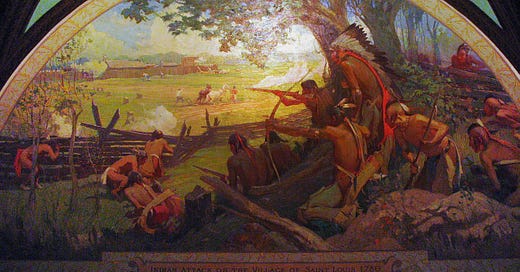On a visit to the first settlement west of the Mississippi, Ste. Genevieve, I was surprised to find out that they had played a critical role in saving my city from being taken by the British.
The surprise was not just the important role of what is now a much smaller town in defending St. Louis, but that I had never heard of the battle at all!
Why had I never heard of this before?
Though it was a battle with huge implications, it was not relevant to the origin story of America happening to the east. This battle has been forgotten in part because it happened in 1780, during the American War for Independence.
Not only that, but no colonial seceding from Britain was involved with this battle at all. (Though colonials were involved with a simultaneous battle in nearby Cahokia.)
The Battle of St. Louis, also called the Battle of Fort San Carlos, was a battle with British-led Indians on one side and French settlers led by Spanish military on the other.
Also, the St. Louis of 1780 was not the large city I grew up in. It was only a village at the time, having been founded just fourteen years before.
Yet the British saw taking St. Louis as the first step in an ambitious campaign. This village was on the west side of the Mississippi River and would be a strategic base for gaining control of the Mississippi Valley.
With no British troops available, the British commander enticed Loyalist trappers to recruit Indians for an attack on St. Louis with an offer of control of the fur trade in upper Spanish Louisiana.
The attacking force eventually consisted of two dozen fur traders and about 1,000 Indians, the largest contingent were Sioux but there were also Chippewa, Menominee, Winnebago, Sauk, Fox and smaller numbers from other nations.
St. Louis only had about 200 men, mostly inexperienced militia. Only 29 were Spanish military. Also, in March, 1780 there were no defenses.
St. Louis was destined to fall to British control, except for two things.
First, word got to the Spanish months before the attack. The commander asked for donations from the townspeople as well as using his private funds to build a tower, Fort San Carlos, to defend the village with cannon. With only enough time to build the one tower, they dug trenches connecting the tower to the Mississippi River so that the village was defended on all sides.
Secondly, an appeal to François Vallé at the French Colonial Valles Mines yielded critical help.
Not only did he send his two sons and 60 well-trained militia from Ste. Genevieve, but he also sent genuine lead musket and cannon balls from his lead mine. This was a huge advantage over the limestone pebbles they would have otherwise been using. Lead is fifteen times heavier than limestone.
Even so, when the attack came on May 26, 1780 every man was critical. If men were drawn out from the defenses then the Indians could pour their larger force against the weak point.
And this brings me to the other, horrible surprise about this event. A horror that had the men begging to leave their trenches during the battle, for the Indians used torture as a tactical weapon.
Some of the villagers had been caught outside the city's defenses when the attack came. When the Indians found the city well defended, they started torturing those they captured so that their screams would draw out the defenders.
The Spanish commander, Lieutenant Governor Fernando de Leyba, refused to let the defenders make a sortie to stop the torture.
Eventually the screams stopped and the Indians departed, destroying and burning as they went.
An attack on nearby Cahokia, just east of St. Louis and home to the Cahokia Mounds, was easily defended by George Rogers Clark and other colonials.
Routed at both St. Louis and Cahokia, the British never again tried to control the Mississippi Valley leaving it in the hands of the Spanish, which allowed it to be purchased by these United States under President Thomas Jefferson twenty three years later.
Some battles involve hundreds of thousands, with tens of thousands of casualties and don't change a thing.
Some battles involve mere hundreds but change the course of history for half a continent.
Hail to the defenders of St. Louis!





I also stumbled upon the Battle of St. Louis recently while at a wedding at the St. Ambrose Cathedral in Des Moines, IA. I happened to notice a stained glass window of a Jean Marie Cardinal, that proclaimed him "the only native Iowan killed in the Revolutionary War." Turns out Cardinal was working in Dubuque-area mines and was part of the group that rushed down the river to warn of the attack on St. Louis. He was killed in the battle. There is a wonderful book called "Chez Les Canses: Three Centuries at Kawsmouth," authored by a Kansas City attorney who traveled to France to read source material on the French in the New World. His view is that the French history in our region is very downplayed, largely because our historians do not read the language!
An excellent article, thoroughly enjoyable and l learnt a lot. Hope to read more about both the Revolutionary War and Civil War on Old Glory Club.